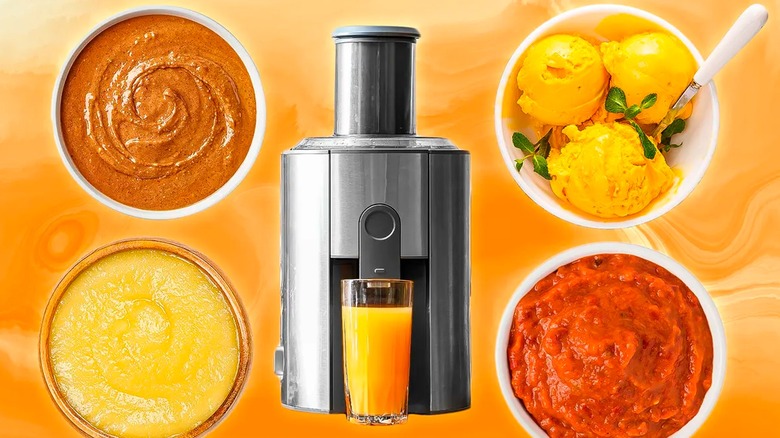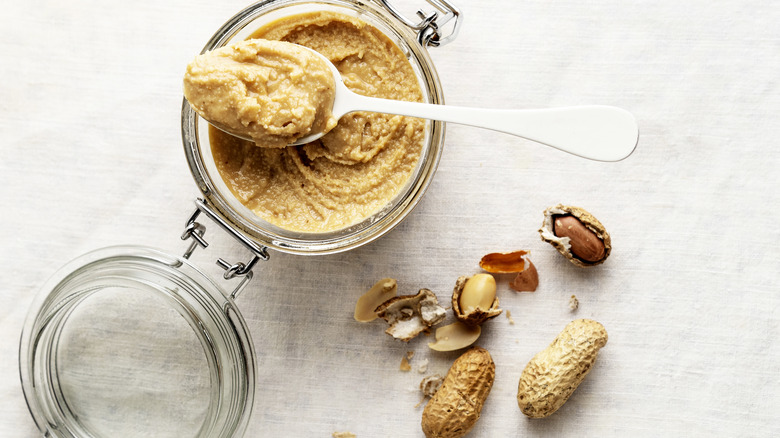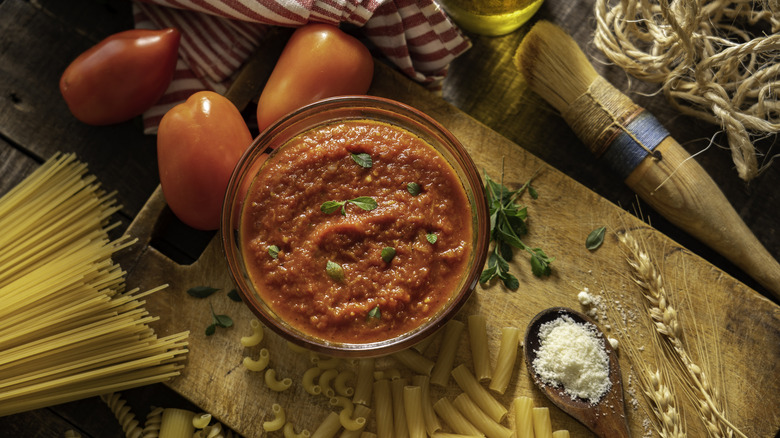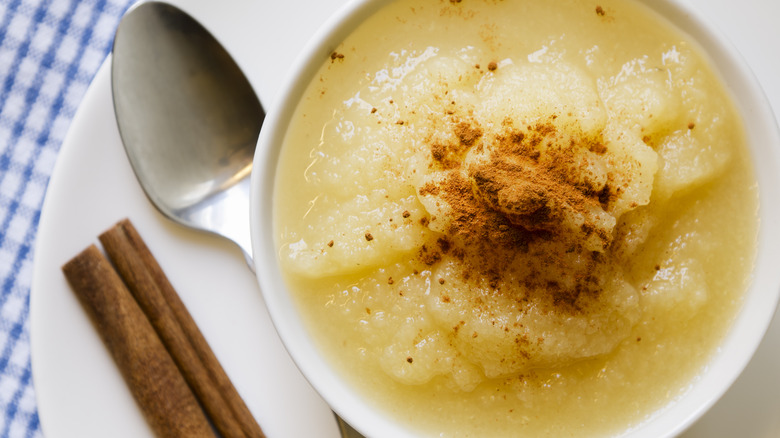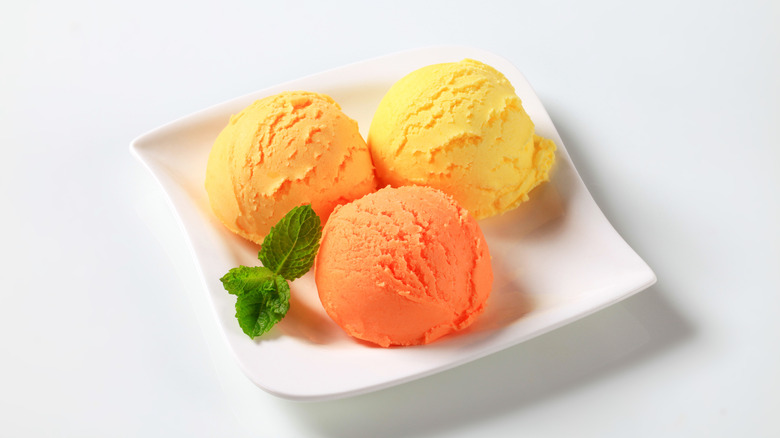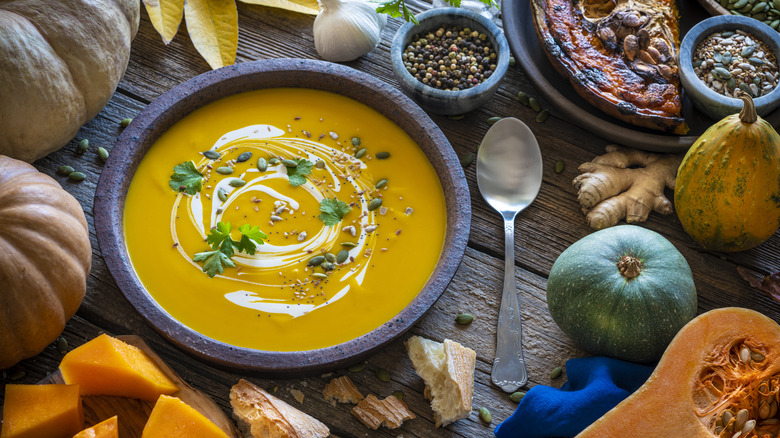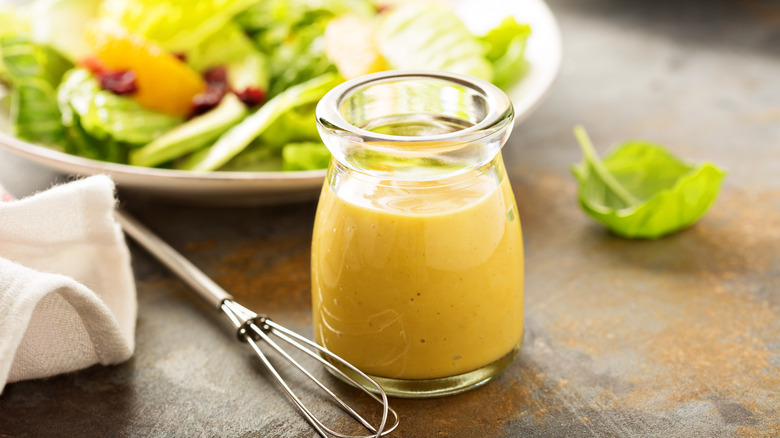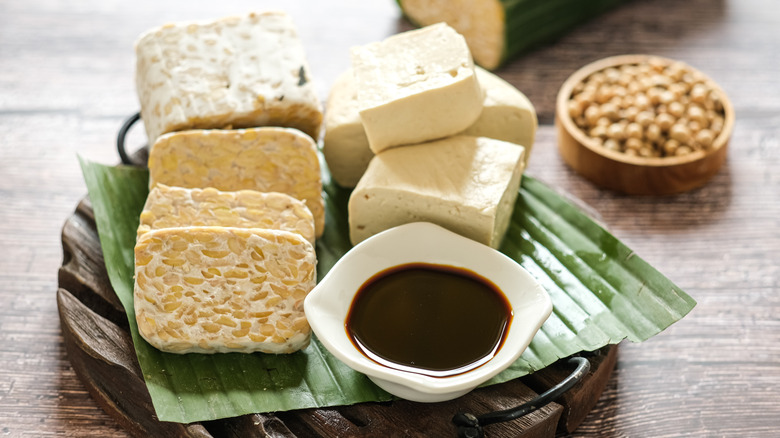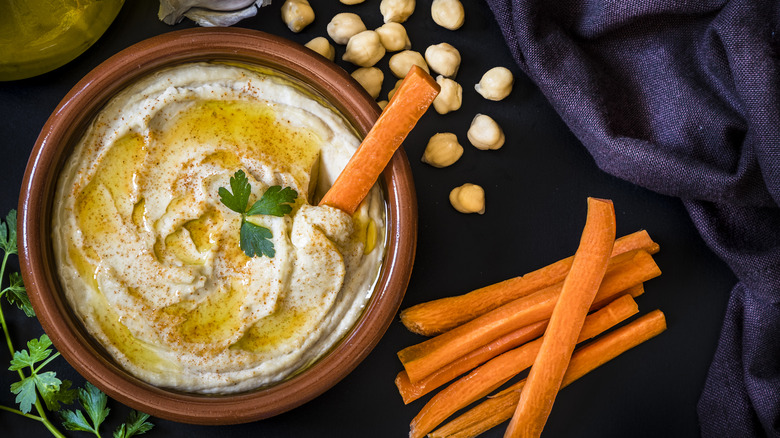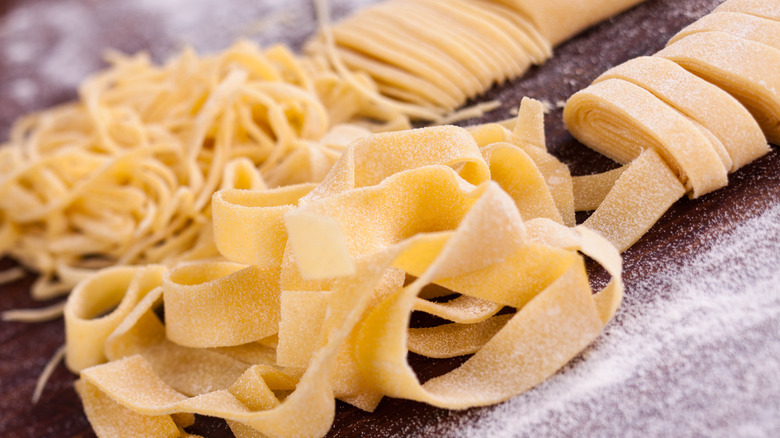14 Unique Uses For Your Juicer
When the daily grind catches up with us, we sometimes don't have the ability to ensure that we're getting all of the vitamins and nutrients required for optimal health and well-being. That's where juicing comes into play. Fresh, cold-pressed juices might seem like a brand new trend popularized by social media influencers, but the practice of extracting juices from fruits and vegetables has roots stretching back centuries. Cold-pressed juices continue to grow in popularity, as grocery prices skyrocket and individuals choose to lead healthier lifestyles by skipping heavily-processed, sugary drinks and going the fresh-pressed, homemade route instead.
Perhaps you've been juicing fruits and veggies for years and feel confident that you have all the tricks for maximizing your juicer's potential down pat. But we can assure you that if you've only ever used this appliance for making fresh, cold-pressed fruit juices, you're missing out on a world of possibilities. Juicers are incredibly versatile, capable of creating a myriad of unique dishes and ingredients effortlessly crafted from scratch. In this list, we'll explore the diverse uses of juicers, from grinding coffee to making desserts, so you can infuse your meals with wholesome goodness and ensure that nutritious eating remains a part of your regular routine.
Blend nuts for smooth and creamy nut butter
While most of us are intimately familiar with peanut butter, spreads made from various other nuts have gained widespread popularity in recent years. You've likely noticed almond, cashew, and hazelnut butter alongside the tried-and-true peanut butter at your local grocer. If you've spotted these alternative nut butters, then you probably also picked up on their enormous price tag. Yikes. But crafting fresh nut butter at home is made simple with a juicer, and if you enjoy cooking with nut butter (or devouring it straight from the jar), then preparing it fresh will save you a pretty penny in the long term.
First, choose the type of nut you want to use for your spread, or craft a unique recipe from a variety of nuts. Use a blank plate, as opposed to a screen, to ensure you get the proper consistency and texture. Add nuts to the juicer slowly for a smooth consistency, or pick up the pace if you prefer a chunkier nut butter. Incorporate sweeteners or spices, depending on what recipe you're using. You can also make fresh, homemade milk from nut butter for all your cereal and smoothie needs.
Make homemade tomato sauce
While jarred sauces offer convenience and consistency, there's nothing like a fresh, handcrafted tomato-based sauce donning a pasta dish. If you learn to make your own homemade sauces, the possibilities become infinite. Your juicer allows you to combine any assortment of herbal and aromatic ingredients to suit your taste or to perfectly complement a recipe. Gone are the days of waiting patiently by the stove, stirring, splattering, and sampling until your kitchen is covered in a thick red mess. Using a juicer to create tomato sauce allows for a quick cleanup and makes whipping up a homemade meal simple and fast.
To make tomato sauce in a juicer, sauté onions and garlic and add them, along with tomatoes and herbs, to the juicer's chute. Use a filter basket that will allow as much pulp to pass through as possible. Experiment with herbs — like basil, oregano, and red pepper — until you find the perfect ratio for a recipe worthy of a place in the family cookbook.
Use a juicer to make fresh applesauce
Both kids and adults love the subtly sweet and cinnamon-infused flavor of applesauce. If you're looking for a sweet treat that won't elicit cavities or an intense sugar rush, a fresh fruit slurry like applesauce is the way to go — especially served warm on a chilly winter day. So the next time you're making apple juice, don't throw away the pulp leftover from juicing. Instead, save it to create a tasty and nutritious treat.
After juicing apples, let the pulp simmer on the stove. Add cinnamon, lemon juice, and your preferred sweetener. Brown sugar adds a robust, molasses flavor, or for a low-sugar treat, try a zero-calorie sweetener like stevia or erythritol. This method will likely yield a chunky sauce, so if you prefer a thinner applesauce, use an immersion blender to smooth the apple chunks. If your applesauce appears too watery, let it simmer until it reduces and thickens to your desired consistency.
Create unique cocktail mixers from scratch
Give your next cocktail a healthful boost with the power of fresh fruits and vegetables. Although using your juicer to make cocktails may be the exact opposite of a juice cleanse, you can still pack in some nutrients and vitamins while relaxing by the pool or hosting a casual cocktail party at home. You'll save money by forgoing the bar, and you'll be surprised by how delicious your homemade concoctions can be compared to a drink hastily thrown together by an overworked bartender on a busy Saturday night.
Your juicer can help create standard mixers — like savory and spicy Bloody Mary mix and tropical piña colada — or your own unique concoctions from juicing any fruit or veggie. Press fresh lemon juice to use in a variety of drinks, like a from-scratch whiskey sour or Tom Collins. Harness the power of beets for an earthy drink made with whiskey, vermouth, and citrus liquor. Or, create a unique (and intensely orange) drink from carrot juice, turmeric, and bitters.
Make nutrient-packed baby food
The best way to ensure that your children are getting the most nutrients possible out of their meals is to prepare them fresh at home. This is especially important for infants. While those baby food jars from the store offer convenience, they can really start to add up cost-wise. And let's face it — not knowing exactly where your little one's meals are coming from can be a bit unnerving. Crafting baby food at home with a juicer is simple and ensures your child receives wholesome, vitamin-rich meals during their crucial developmental years.
Use a homogenizing body attachment on your juicer to achieve the perfect consistency for baby food. This piece breaks down fruits and veggies while retaining fiber, so you don't lose precious nutritional content in your baby's food. Experiment with different combinations of fruits and veggies to find the perfect blend that your infant loves. If you wind up with leftovers, add baby food made with fruit to homemade margaritas for an added burst of fresh fruit flavor. You can also use leftover baby food in cake batter to up the dessert's nutrient and moisture content.
Create your own skincare products with a juicer
Let's face it (pun absolutely intended) — keeping up with a skincare routine is costly. While it seems like you have to purchase a slew of expensive items just so you can stay looking and feeling your best, you don't have to succumb to the pricy products at the pharmacy for an effective skincare regime. Your juicer is an unlikely ally for creating moisturizing products for skin made from ingredients that you can find at the grocery store. All-natural skincare is safe and effective, and you'll feel good knowing that you're saving money, while nursing your body with wholesome, plant-based ingredients.
Juice a blend of fruits and veggies — like cucumber and lemon for their soothing, hydrating properties — and soak a cotton sheet mask in the juice. Allow the mask to chill in the fridge for about 30 minutes, and voila! A simple, cost-effective skincare product made from scratch nourishes your skin and keeps your face looking bright and healthy. Invite friends over for a DIY spa day and make your own unique blends for an exciting and creative night of fun.
Make health-conscious ice cream and sorbet
When it's late at night and that infamous sugar craving hits, you don't have to reach for sweets loaded with refined sugar and artificial preservatives. Instead, use your juicer to make delicious, café-quality sorbet from frozen fruit with just one easy step. Simply feed frozen fruit into your juicer, ensuring you use an attachment that allows the entire fruit to pass through. The result will be a creamy delight with a thick consistency that's ideal for a frozen treat.
Use bagged frozen fruit or slice fresh fruit and freeze ahead of time to make sorbet in your juicer. Almost any fruit will do, but bananas lend to an ultra-creamy, one-ingredient dessert that tastes just like ice cream, with nutrients and only natural sugars to boot. For a sorbet loaded with layers of flavor, use frozen mango and top with lime, salt, and chili powder. This sweet-and-salty treat is a spicy favorite in Mexico for good reason. Get even more creative and infuse your sorbet with a boozy addition. Vodka makes sorbet ultra-creamy, and this recipe is sure to intrigue guests at a party when you pull out the juicer, instead of the cocktail mixers.
Skip the vegetable juice and make a veggie-packed soup
While making your own vegetable juice is an efficient and delicious way to pack some vitamins into your diet, drinking vegetable juice on the regular can get boring. The next time you're planning on making your own version of V8 juice, use a similar recipe to craft a soup instead. All you need is your favorite combination of veggies and whatever herbs and seasonings suit your preference. Change up the recipe weekly to keep meals for the whole family both exciting and nutritious.
Insert your veggies into the juicer the same way you would while making juice, but add herbs and spices. Try a tomato carrot soup with dill and garlic or a creamy carrot avocado soup with cilantro and lime. You can also create a soup with a large variety of veggies, seasoned however you like, to optimize vitamin content. After the ingredients are in juice form, simmer on the stove for about 20 minutes. These recipes are both delicious and incredibly simple to prepare, so you can even involve the kids in the kitchen, encouraging them to participate and learn about healthy eating habits.
Get creative with salad dressings
Few meals are as versatile and fun to prepare at home as salads. All you need is a base of greens, your favorite toppings, and — most importantly — a delicious, made-from-scratch dressing. Bottled, store-bought dressings are typically high in sodium, sugar, and other ingredients that can jeopardize an otherwise nutritious salad. Preparing dressings at home allows you to infuse them with fresh, healthy ingredients and craft a unique recipe specific to the salad you plan to prepare.
It's a breeze to whip up a delicious dressing with only three or four simple ingredients. Juice beets and oranges, then add balsamic vinegar for a sweet and tangy dressing ideal for a salad made with avocado, nuts, and mandarin orange slices. Or juice tomato, onion, garlic, and thyme for a deep savory dressing to adorn a salad with corn and spicy peppers. Use your juicer to juice pineapple, then add habanero hot sauce and apple cider vinegar for a unique sweet heat dressing for summer. Let your creativity flow as you create a one-of-a-kind dressing, then prepare a meal that complements it perfectly.
Create homemade tofu
Tofu — a patty made from condensed soy milk — has been a staple in Chinese cuisine for centuries. It eventually made its way to the West, where it's now a necessity for vegan and vegetarian cooking. Tofu is celebrated for its firm texture, which is used to mimic meat or act as a distinct ingredient, adding protein and calcium to a plethora of delicious tofu-centric recipes. To make a meal entirely from scratch, you can craft your own tofu at home. The process may seem daunting at first, but preparing a fresh batch of tofu is made simple with a juicer.
To make tofu in your juicer, first soak soybeans overnight until they've tripled in size. Attach a fine strainer to your juicer and feed an equal amount of soybeans and water into the chute. Include vegetables, like spinach, with the soybeans and water if you want to impart a subtle flavor to your tofu. Once you've collected a large amount of soy milk, boil it and add a coagulant. Pour the tofu into a tofu press and admire your creation and newfound DIY skill.
Make fresh hummus in a juicer
Store-bought hummus can be pricy, but creating hummus at home is fast, fun, and foolproof with a juicer. This creamy concoction is perfect for dipping chips, spreading on pita bread, or eating straight up with a spoon. A typical recipe for hummus involves chickpeas and tahini along with garlic, lemon juice, and olive oil for garnishing; you don't have to alter the recipe to prepare this time-honored dip in a juicer. Making hummus in your juicer allows you to easily control the consistency of the spread, while adding any ingredients you'd like to boost its flavor.
To make hummus in your juicer, simply feed canned chickpeas into the machine without draining them. Include the can's liquid in your recipe, adjusting the amount of liquid to achieve your desired thickness. Keep the control lever partially open to ensure all the chickpeas are processed. Once you have a smooth bean mash, mix in crushed roasted garlic or garlic powder, tahini, and lemon juice, resulting in a universally-loved creamy, nutritious, and flavorful dip.
Create your own essential oils
You may have noticed more and more content about essential oils popping up on your Instagram feed over the past few years. While there's some debate over whether essential oils can potentially treat or cure diseases, there are undoubtedly practical uses for these oils in the kitchen, as well as in skincare, cosmetics, and aromatherapy. Unlike extracts, essential oils are exceptionally concentrated and are created through a process that doesn't involve dilution. As helpful as essential oils are, they also come with a hefty price tag, so instead of shelling out oodles of dough, make essential oils at home using your juicer.
Different methods are used to create essential oils, one being cold extraction. This method works particularly well when crafting lemon oil. Mix lemon peels with pectin enzymes for use in lotions, candles, and baking, and then press the mixture in your juicer. The result yields a thick, cloudy, and adhesive-like paste that will eventually separate and clear after it sits overnight in your pantry. Freeze the lemon oil for future projects, and then treat yourself to a fancy night on the town with all the money you saved.
Make pasta dough
Few things are as satisfying to create by hand as pasta dough. You likely assume that an expensive, Italian-made machine is necessary for producing tender pasta noodles, but think again; you can add "pasta creation" to your juicer's extensive catalog of uses, too. With the best juicer for the job, a meal made from the aforementioned homemade tomato sauce and fresh pasta is only a press and click away.
If your juicer comes with a homogenizing blank and pasta nozzle, put the tools to work and make dough from scratch. Some juicers even have the ability to knead the pasta dough, but while this is incredibly nifty, it's not necessary. Start by mixing flour, water, eggs, and salt in a large bowl, adding more water until the dough is the right consistency. Then, feed the dough into the chute and cut your pasta to the preferred length. You can even infuse your dough with a paste made from herbs and veggies for a unique and colorful pasta creation you can't find at a supermarket.
Grind coffee beans, nuts, or cinnamon sticks
If you love grinding coffee beans for an ultra-fresh cup of joe every morning, don't spend extra money on a coffee grinder. The right juicer can get the job done, no sweat. Many horizontal juicers include a grinding function, which can be used to grind coffee beans, cinnamon sticks, nuts, and peppercorns, so make sure your juicer is capable before you stock up on whole bean coffee.
When using your juicer to grind coffee, make sure to add the beans to the chute gradually to achieve a consistent grind. Inconsistent grinding can lead to coffee with a weaker flavor profile and the potential for sour or bitter notes. Employ the same technique for grinding various other ingredients from scratch. Whether it's spices, beans, or nuts, freshly-ground ingredients add an extra dimension of flavor to any recipe, all while being easy on your wallet. As you grind, enjoy the sweet or earthy aromas emanating from your juicer, and revel in the fact that your juicer is a powerhouse, acting as the perfect kitchen multitool.
